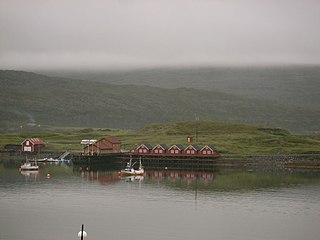Related Research Articles

In aviation, instrument flight rules (IFR) is one of two sets of regulations governing all aspects of civil aviation aircraft operations; the other is visual flight rules (VFR).

Diamond dust is a ground-level cloud composed of tiny ice crystals. This meteorological phenomenon is also referred to simply as ice crystals and is reported in the METAR code as IC. Diamond dust generally forms under otherwise clear or nearly clear skies, so it is sometimes referred to as clear-sky precipitation. Diamond dust is most commonly observed in Antarctica and the Arctic, but can occur anywhere with a temperature well below freezing. In the polar regions of Earth, diamond dust may persist for several days without interruption.

The sky is an unobstructed view upward from the surface of the Earth. It includes the atmosphere and outer space. It may also be considered a place between the ground and outer space, thus distinct from outer space.

A cloud base is the lowest altitude of the visible portion of a cloud. It is traditionally expressed either in metres or feet above mean sea level or above a planetary surface, or as the pressure level corresponding to this altitude in hectopascals.

In aviation and aviation meteorology, a flight level (FL) is an aircraft's altitude at standard air pressure, expressed in hundreds of feet. The air pressure is computed assuming an International Standard Atmosphere pressure of 1013.25 hPa (29.92 inHg) at sea level, and therefore is not necessarily the same as the aircraft's actual altitude, either above sea level or above ground level.
METAR is a format for reporting weather information. A METAR weather report is predominantly used by aircraft pilots, and by meteorologists, who use aggregated METAR information to assist in weather forecasting.

Whiteout, white-out, or milky weather is a weather condition in which the contours and landmarks in a snow-covered zone become almost indistinguishable. It could be also applied when visibility and contours are greatly reduced by sand. The horizon disappears from view while the sky and landscape appear featureless, leaving no points of visual reference by which to navigate; there is absence of shadows because the light arrives in equal measure from all possible directions. Whiteout has been defined as: "A condition of diffuse light when no shadows are cast, due to a continuous white cloud layer appearing to merge with the white snow surface. No surface irregularities of the snow are visible, but a dark object may be clearly seen. There is no visible horizon."
The world's navigable airspace is divided into three-dimensional segments, each of which is assigned to a specific class. Most nations adhere to the classification specified by the International Civil Aviation Organization (ICAO) and described below, though they might use only some of the classes defined below, and significantly alter the exact rules and requirements. Similarly, individual nations may also designate special use airspace (SUA) with further rules for reasons of national security or safety.
In meteorology and aviation, terminal aerodrome forecast (TAF) is a format for reporting weather forecast information, particularly as it relates to aviation. TAFs are issued at least four times a day, every six hours, for major civil airfields: 0000, 0600, 1200 and 1800 UTC, and generally apply to a 24- or 30-hour period, and an area within approximately five statute miles (8.0 km) from the center of an airport runway complex. TAFs are issued every three hours for military airfields and some civil airfields and cover a period ranging from 3 hours to 30 hours.
A pilot report or PIREP is a report of actual flight or ground conditions encountered by an aircraft. Reports commonly include information about atmospheric conditions or airport conditions. This information is usually relayed by radio to the nearest ground station, but other options also exist in some regions. The message would then be encoded and relayed to other weather offices and air traffic service units.
VFR over-the-top (OTT) refers to flying over top of clouds in visual flight, rather than with reference to instruments. This is usually done for brief amount of time to avoid weather or turbulence.

Overcast or overcast weather, as defined by the World Meteorological Organization, is the meteorological condition of clouds obscuring at least 95% of the sky. However, the total cloud cover must not be entirely due to obscuring phenomena near the surface, such as fog.
Colour states is a system used for quickly showing meteorological conditions.

In meteorology, an okta is a unit of measurement used to describe the amount of cloud cover at any given location such as a weather station. Sky conditions are estimated in terms of how many eighths of the sky are covered in cloud, ranging from 0 oktas through to 8 oktas. In addition, in the SYNOP code there is an extra cloud cover indicator '9' indicating that the sky is totally obscured, usually due to dense fog or heavy snow.

In meteorology, station models are symbolic illustrations showing the weather occurring at a given reporting station. Meteorologists created the station model to fit a number of weather elements into a small space on weather maps. This allows map users to analyze patterns in atmospheric pressure, temperature, wind speed and direction, cloud cover, precipitation, and other parameters. The most common station plots depict surface weather observations although upper air plots at various mandatory levels are also frequently depicted.

Airport weather stations are automated sensor suites which are designed to serve aviation and meteorological operations, weather forecasting and climatology. Automated airport weather stations have become part of the backbone of weather observing in the United States and Canada and are becoming increasingly more prevalent worldwide due to their efficiency and cost-savings.

American Airlines Flight 723 was a scheduled American Airlines flight from Boston Airport in Massachusetts, to Chicago Midway Airport in Illinois. On September 16, 1953, a Convair 240 propliner flying this route crashed while attempting to land at Albany Airport in upstate New York, killing all 28 people on board.

AeroUnion Flight 302, operated by an Airbus A300B4-203F cargo aircraft, crashed in poor weather on final approach at General Mariano Escobedo International Airport, Monterrey, Mexico around 23:18 CDT on 13 April 2010, after a flight from Mexico City. All five people on board were killed, as well as one on the ground.

Swiss International Air Lines Flight 850 was an international scheduled passenger flight from Basle, Switzerland, to Hamburg, Germany. On 10 July 2002, the flight was unable to land at Fuhlsbüttel Airport due to weather. Attempts were made to divert to other airports at Berlin and Eberswalde before the crew decided to land at Werneuchen. On landing, the aircraft struck an earth bank which ripped off all three undercarriage legs, and came to rest on its belly with an engine on fire. One of the sixteen passengers suffered minor injuries. The aircraft was written off.

This glossary of meteorology is a list of terms and concepts relevant to meteorology and atmospheric science, their sub-disciplines, and related fields.
References
- ↑ METAR
- ↑ UK Air Navigation Order, Section 1, part 33: " ‘Cloud ceiling’ means the height above the ground or water of the base of the lowest layer of cloud below 6000m which, when visible from the aerodrome, is sufficient to obscure more than half the sky". From http://caa.co.uk/CAP393.
- ↑ Section 1.1 14 CFR Part 1 - Definitions - Federal Air Regulations